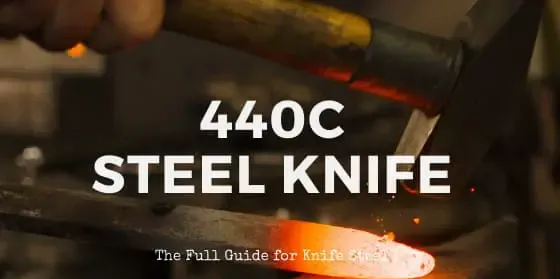When it comes to stainless steel, AISI 440C (X105CrMo17) stands out as one of the top choices in the 400 series. Known for its high carbon content, 440C stainless steel offers exceptional hardness (58-60HRC) and is highly resistant to corrosion and heat.
In this guide, we will explore the process of hardening 440C stainless steel, its applications, and important considerations to achieve the best results.
Understanding 440C Stainless Steel
440C stainless steel belongs to the older generation of steels but is still widely used today due to its reliability and cost-effectiveness.

Although newer high-alloyed steels have emerged, 440C stainless steel continues to hold its own. It’s important to note that there are some misconceptions surrounding this steel, which we will address later in this guide.
Applications of 440C Stainless Steel
440C stainless steel finds its applications in various industries. It is commonly used for manufacturing ball bearings, bushings, valve parts, and cutlery. Additionally, it is widely utilized in the production of balls, rollers, needles, and rings for corrosion-resistant bearings.
The high chromium and carbon content in 440C stainless steel contribute to its excellent wear resistance, making it a preferred choice in these applications.
440C Stainless Steel equivalent materials and material specifications
Equivalent Materials:
- AISI 440C
- UNS S44004
- X105CrMo17 (1.4125)
- SUS440C
- G440C
- 9Cr18Mo
- X90CrMoV18
Material Specifications:
- ASTM A276: Standard Specification for Stainless Steel Bars and Shapes
- ASTM A756: Standard Specification for Stainless Anti-Friction Bearing Steel
- ASTM A580/A580M: Standard Specification for Stainless Steel Wire
- AMS 5630: Aerospace Material Specification for Steel Bars, Wire, Forgings, Tubing, and Rings, Corrosion and Heat Resistant, 18Cr – 16Ni – 2Mo, Solution Heat Treated
- AMS 5880: Aerospace Material Specification for Steel, Corrosion and Heat Resistant, Bars, Wire, Forgings, Tubing, and Rings, 18Cr – 16Ni – 2Mo, Solution Heat Treated, Precipitation Hardenable
Chemical Composition
440C stainless steel has the following chemical composition:
- Carbon (C): 0.95-1.10%
- Silicon (Si): <0.80%
- Manganese (Mn): <0.80%
- Phosphorus (P): <0.035%
- Sulfur (S): <0.030%
- Molybdenum (Mo): 0.40-0.70%
- Chromium (Cr): 16.00-18.00%
440C Stainless Steel mechanical properties
| Mechanical Property | Value |
|---|---|
| Hardness (Rockwell C) | 58-60 HRC |
| Tensile Strength | 760-1030 MPa |
| Yield Strength | 450-1650 MPa |
| Elongation | 14-20% |
| Modulus of Elasticity | 200 GPa |
| Poisson’s Ratio | 0.27-0.30 |
| Density | 7.75 g/cm³ |
| Thermal Conductivity | 24 W/m·K |
| Specific Heat Capacity | 460 J/kg·K |
| Electrical Resistivity | 0.60 µΩ·m |
| Magnetic Properties | Magnetic |
Heat Treatment
To ensure proper hardening of 440C stainless steel, it is crucial to protect it from oxidation and decarburization during the process. Using anti-scale compounds like Cordusal, Turco, and ATP-641 is highly recommended to prevent surface scale formation that may require additional post-heat treatment surface preparation.
Austenitizing and Hardening
The recommended temperature range for austenitizing 440C stainless steel is 1040°C-1066°C (1900°F – 1950°F). It is essential to strike a balance between achieving high hardness and avoiding the formation of large grain sizes, which can reduce toughness.
Soak times vary based on the thickness of the material, ranging from 5 minutes to 30 minutes. Quenching can be done in a medium-speed oil or using aluminum plates and compressed air to temperatures below 125°F (50°C).
Cryogenic Processing
Cryogenic treatment is highly beneficial for 440C stainless steel as it helps convert retained austenite and increases its hardness. Deep Cryogenic Treatment (DCT) can increase hardness by 7%, while Shallow Cryogenic Treatment (SCT) offers a 4% increase.
Liquid nitrogen is the preferred medium for cryogenic treatment, but a sub-zero bath with dry ice and kerosene can also be used.
Tempering
Tempering is a critical step to achieve the desired hardness and optimize the performance of 440C stainless steel. Recommended tempering temperatures range from 149°C (300°F) to 260°C (500°F), depending on the desired hardness level.
It is important to avoid tempering above 425°C (800°F) as it can reduce toughness and corrosion resistance. Multiple tempering cycles, each lasting two hours, are recommended to achieve the desired results.
Conclusion
440C stainless steel continues to be a popular choice for various applications due to its excellent hardness and corrosion resistance. By following the proper hardening process, including heat treatment, austenitizing, quenching, cryogenic processing, and tempering, you can optimize the performance of 440C stainless steel for your specific needs.
